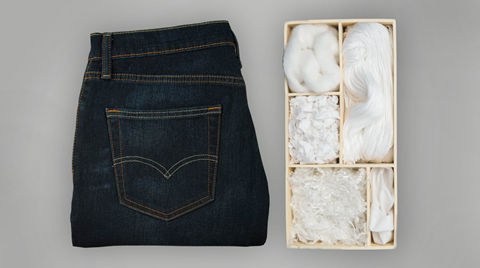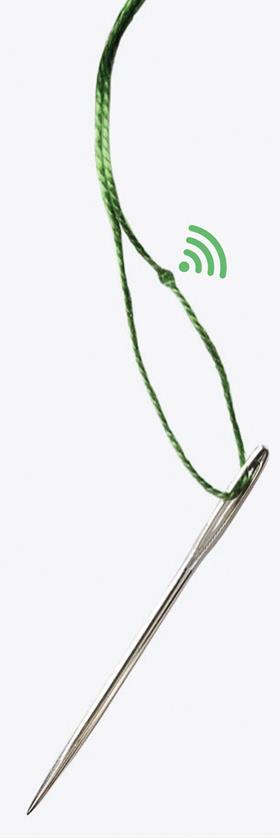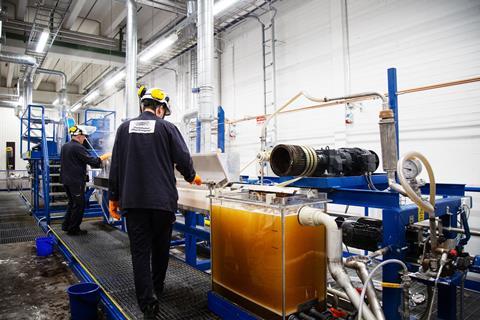Nina Notman explores how chemistry is poised to close the loop in clothing recycling
The term ‘fast fashion’ was coined in the 1990s to describe trends that move rapidly from the catwalk onto our high streets. Some brands now produce new collections weekly, often selling them at very low cost. In recent decades, the number of clothes purchased globally has skyrocketed. Like fast food, however, fast fashion has some serious drawbacks. Many of these clothes, for example, travel nearly as quickly through our wardrobes and into the bin.
Today, plastic recycling is very much in vogue, partly thanks to widely publicised problems with plastic pollution. Public appreciation of the need to apply the three Rs – reduce, reuse and recycle – to this material is at an all-time high. Awareness of the need to apply the same logic to our clothing, however, remains firmly out of the spotlight.
Textile production, especially those made from synthetic polymers, uses a huge amount of non-renewable natural resources: 98 million tonnes of oil globally each year, according to the Ellen MacArthur Foundation, a UK charity set up by the solo long-distance yachtswoman to promote a circular economy. The fashion industry also uses vast quantities of water and is a significant contributor to the climate emergency, with greenhouse emissions on the same order of magnitude as international flights and maritime shipping combined. There is also a large societal impact that isn’t considered in this article.
The sector has made changes to address garment production’s environmental impact, but they are swimming against a tide of ever-increasing fashion purchases. To slash the environmental impact of clothing, we need to buy less and wear what we do buy more often. The Ellen MacArthur Foundation calculated that customers miss out on $460 billion (£360 billion) of value in clothes globally each year due to discarding them before the end of their useful life.
You cannot take a well-used T-shirt, tear it apart and then make it into a new T-shirt
More needs to be done to extend the life of garments once we are bored of wearing them – less hoarding and more donating to charity, buying second-hand and renting formal wear. But action is also needed to better capture the value of the resources in clothing that has genuinely reached the end of its life – and this is where chemistry has a role to play.
Regeneration potential
Globally 73% of material that goes into clothing ends up either in landfill or an incinerator, reports the Ellen MacArthur Foundation. Just 12% gets recycled. In the UK, this recycling figure drops to 9%, according to the charity Wrap (Waste and Resources Action Programme).
Most garments that are recycled are down-cycled into industrial cleaning cloths, insulation material and mattress stuffing. Today, less than 1% of the material in clothing is recycled into new garments. The polyester in clothes labelled as being made from recycled materials mostly originates from recycled bottles.
Only with a chemical approach can we get the raw materials back and close the loop on textile recycling
The biggest issue holding garment-to-garment recycling back is fibre quality: fibres are damaged during both wearing and washing. ‘You cannot take a well-used cotton T-shirt, mechanically tear it apart and then make the cotton fibres into a new cotton T-shirt, because they have lost so much fibre quality that the T-shirt will not be of high enough quality to fit into the market,’ explains Hanna de la Motte, a textile recycling chemist at RISE Research Institutes of Sweden in Göteborg. Shredding also tends to shorten fibre length.
One option is to mix mechanically recycled fibres in with virgin fibres. Another possibility – being explored by de la Motte and others – is to chemically break fibres down into their chemical building blocks and then rebuild them into new fibres with indistinguishable (or better) performance characteristics than virgin fibres. ‘Only with a chemical approach can we get the raw materials back and close the loop on textile recycling,’ explains Adam Walker, a physical chemist and chief scientific officer for Worn Again Technologies in Nottingham, UK.
Chemical fibre-to-fibre recycling is challenging both technically and economically, however: the resulting fibre can’t be more expensive than the market will accept. Following a handful of successful pilots, this technology is now starting to make its commercial debut.
Cottoning on
The variety of fibre types on the market is a significant issue facing budding textile recyclers. Different fibres require different chemicals to break them down, so once used clothing is collected, the first stage is sorting. ‘You need to have very good, fast sorting facilities that are accurate and able to direct the right materials to the right recycling method,’ says de la Motte, ‘We don’t really have those on the market yet.’ There are, however, potential solutions in the pipeline (see Sorting it all out below).

A number of pilots have looked at chemically recycling cotton, which accounts for just under a third of all fibres used in textile production. These pilots all have the same basic steps: mechanical removal of items such as zips and buttons, washing to remove dyes and the like, dissolving the cotton cellulose in a solvent and then spinning new fibres from the resulting pulp.
The fibre produced varies, with some pilots producing well-established fibres and others novel yarns. Evrnu, in Seattle, US, for example, is ‘ready to license the technology to produce fibres from 100% post-consumer cotton using all currently available regenerated cellulose systems such as Lyocell, Rayon, Cupro, and Acetate’, says Christopher Stanev, the company’s co-founder and president. It is also developing technology to produce a novel fibre named NuCycl. ‘We have been able to take cotton and make it into fibres that are […] stronger than the cotton in its original form,’ Stanev says. ‘We can produce up to 1 ton of dissolved pulp from post-consumer garments per day.’ Both Adidas and Levi Strauss have already produced limited edition garments containing NuCycl mixed with virgin fibres.
Neither the chemistry used in the dissolution step nor the chemical makeup of NuCycl has been divulged. In Finland, however, Infinited Fiber (a VTT Technical Research Centre of Finland spin-out) has revealed that it is recycling cotton into a novel cellulose carbonate fibre. The cellulose is modified before the dissolution step by the addition of urea. Heat is applied to break the urea down to form isocyanic acid, which the hydroxyl groups on the cellulose react with to form carbamates. This is then dissolved and the resulting pulp regenerated into fibres using the viscose process. ‘We can utilise old viscose plants,’ explains Harlin Ali, a textile research professor at VTT and co-founder of Infinited Fiber. However, this fibre production process has environmental and safety advantages over those for viscose, including eliminating the use of carbon disulfide.
The carbonate fibre’s feel and strength is comparable with virgin cotton fibres. ‘We have applied them to make T-shirts, sweaters, jeans and towels,’ says Ali. Since early 2018, Infinited Fiber has been operating a 50 ton per annum pilot plant near VTT in Espoo. ‘A new 500 ton per annum plant will start operations early next year and 25,000 tons per annum factory is planned late 2021,’ he adds. Its fibre has been tested by global brands including H&M and VF Corporation. And like Evrnu, Infinited Fiber’s end goal is to license the technology to others.
Sorting it all out

A significant challenge for textile recycling, both manual and chemical, is sorting collected garments by fabric type. This is currently done by hand – which is slow and also problematic if garment labels are unreadable or removed. Automated systems are in development.
Infrared sensors – already in use commercially for plastics – is one approach being tested. RFID tags are another. Advanced E-Textiles (Adetexs) in Nottingham, UK, for example, has designed an RFID yarn that can be woven into garment seams. ‘Most RFID tags in the garment industry are large paper hanging tags’ that are removed upon purchase, explains Anura Rathnayake, Adetexs founder and chief scientific officer. ‘We’ve developed a flexible, washable thread’ that remains in garments throughout their lifetime, he says.
The Adetexs RFID thread won an H&M Global Change Award in 2017, and is currently being trialled by several global brands, says Rathnayake. The thread’s utility extends beyond easy recyclability. ‘It will benefit the entire supply chain’ from initial stock management, enabling easy self-checkouts in stores, and even for informing smart washing machines as to which setting is required, he explains. ‘If you introduce something only for benefit of a recycler, it’s hard to get brand owners interested,’ he adds. ‘But if you provide a technology for use throughout entire supply chain’ it’s much easier to get people on board.
Separating the seemingly inseparable
Many fabrics on the market that feel like cotton are blends of two or more different fibre types tightly woven together. Polycotton, for example, combines the soft, breathable characteristics of cotton with the durability and easy care of polyester.
To recycle both the polyester and the cotton components of this blend, the recycling process must first separate them. This isn’t easy mechanically, but can be achieved chemically by playing on the different physical properties of the two fibres. ‘For polycotton, we need to extract two polymers with very different solubility characteristics,’ Walker explains.
The first steps in Worn Again Technologies’ process are similar to those developed for cotton-only chemical recycling: metal removal followed by washing. ‘We swell the polyester fibres to leach out any small molecule contaminants like dyes and so on,’ says Walker. Other polymers, such polyurethane and cellulose acetate, are also washed out during this stage.
For polycotton, we need to extract two polymers with very different solubility characteristics
All that is left behind after washing is pure polycotton saturated with solvent. Next, this is heated up. ‘At a higher temperature, the polyester dissolves and goes into solution, leaving the cotton behind as a solid,’ Walker says. The cotton and polyester are then separated by filtration.
Next, they separate the solvent from the polymer, restore the polymer to the correct molecular weight distribution for reuse in the textiles market and send it off to be spun back into polyester fibre using existing infrastructure, Walker explains. ‘The PET [polyethylene terephthalate] we produce is exactly the same as a virgin PET pellet that would come out of a polymerisation plant.’
The solid cotton fibres are then dissolved using a novel ionic liquid. ‘The resultant viscous dope can be processed in a number of ways,’ says Walker. ‘What we’re doing currently is making a pulp, which is equivalent to a wood pulp, and that can be used as a raw material for existing cellulosic fibre spinning processes.’ Viscose or lyocell are both examples of fabric that are currently produced from wood pulp.
Worn Again Technologies is building a demonstration sub-pilot plant, also with the end goal of licensing the technology to others. ‘We are currently commissioning our pilot operational plant to validate the product in the supply chain,’ says Walker. ‘Commercial operations will follow successful trials.’ The company already has big name partners and investors including global clothing chain H&M.
Scaling up
The Hong Kong Research Institute of Textiles and Apparel (HKRITA) has also received funding from H&M to explore two novel polycotton recycling technologies. Both of these dissolve the cotton component of the blend and leave the polyester fibres intact.

The furthest ahead of the HKRITA processes is a green solvent-based technology coined the Green Machine. The type of solvent used hasn’t been revealed. ‘Material characterisations show that the polyester fibres have almost no molecular weight reduction and have similar mechanical properties to the virgin fibres,’ explains Alex Chan, research manager at HKRITA. The team is exploring how best to reuse the cellulose pulp recovered.
‘Preliminary economic analysis shows that the recycling process is commercially viable,’ says Chan. The current system has a processing capacity of 100kg per day, meaning it can process up to a textiles input of 3 tons annually. ‘We are developing a further scale-up system, targeting more than 1 ton per day, [which we] expected to complete in six months,’ Chan explains
The second polycotton recycling process in development at HKRITA carries out an enzyme hydrolysis of the cotton component in a bioreactor. Scale up to a system with ‘at least 40kg input per day’ is currently underway, says Chan. Detailed economic analysis is also being undertaken, he adds.
Meanwhile in Sweden, the forest company Södra has recently announced it has started commercialising recycling of the cotton from polycotton. In autumn 2019, 30 tonnes of waste textiles were converted into pulp at the company’s wood pulp mill in Mörrum. The long-term target for this so-called OnceMore process is to recycle 25,000 tonnes of textiles per annum. In its announcement, Södra also said it will be investigating ‘the possibility of extracting a stream of residual products from the polyester’.
Södra’s interest in textile recycling started in 2011, as part of a large collaboration – called Blend Re:Wind – led by de la Motte. In the Blend Re:wind process, polycotton is treated with sodium hydroxide to ‘degrade the polyester into its building blocks’, she explains. The monomers dissolve in the base, but the cotton does not, allowing separation by filtration. ‘The technology has served as inspiration to the OnceMore process of Södra,’ de la Motte adds.
The polycotton recycled so far in Mörrum has come from textile rental firm Berendsen. It includes end-of-life sheets, towels, tablecloths and bathrobes, from hospitals and hotels. Other sources of textiles are needed to enable scale up. ‘We are now seeking companies with high sustainability ambitions that would like to partner with us in the delivery of textiles,’ Helena Claesson, project manager at Södra, said when the initiative was announced.
Considering the increased interest in textile recycling technologies I expect it will start to increase
Worn Again Technologies’ Walker explains that economies of scale will be necessary for any of the chemical textile recycling technologies to take off. ‘Chemical recycling only makes sense if you’ve got enough throughput through your plant to be able to generate really large quantities – five figure tonne quantities – of output per annum,’ he says. Evrnu’s Stanev put the figure as even larger: calculations show that you need to produce ‘at least a 100k tonnes a year for the cost of manufacturing to be comparable to current alternatives made from wood pulp cellulose’.
The advantage of using rental textiles is that the composition of the fabric is known. Other sources of recyclable textiles include those collected by brands through initiatives such as the global H&M Garment Collecting programme, items donated to charity and those placed in kerb-side recycling boxes. But, as already noted, the infrastructure for sorting these garments is not yet in place.
Regardless, the future for the chemical recycling of textiles is widely expected to be bright. ‘Considering the increased interest in textile recycling technologies and the research put into these in the last 10 years, I expect [chemical] textile recycling will start to increase,’ explains Gustav Sandin Albertsson, an expert in life cycle assessments of textile at the IVL Swedish Environmental Research Institute in Göteborg.
Stanev agrees, saying he expects textile recycling to replicate the success of paper. ‘The paper recycling industry started 30 years ago and has developed into a very smooth system of recycling and reusing the same resources over and over again in boxes, brown paper and white paper,’ he says. ‘We will be using a very similar model, but in the textile industry.’
Nina Notman is a science writer based in Salisbury, UK













No comments yet